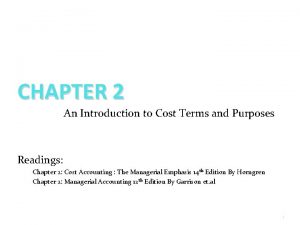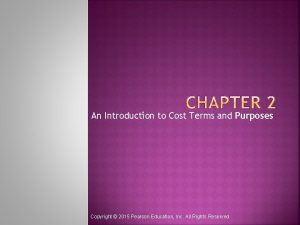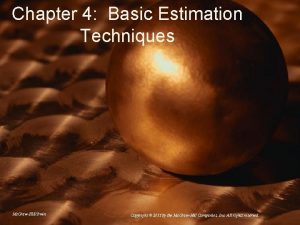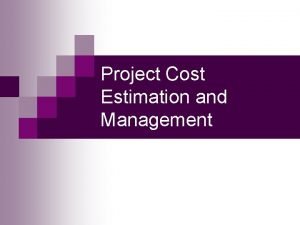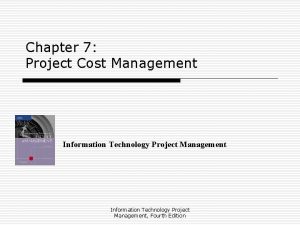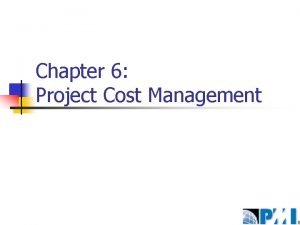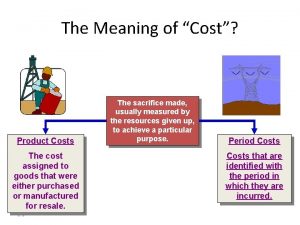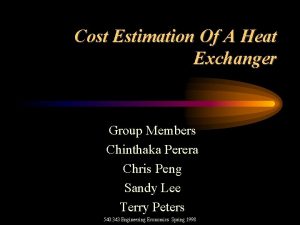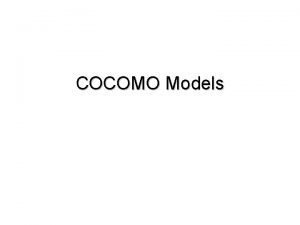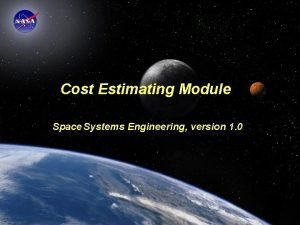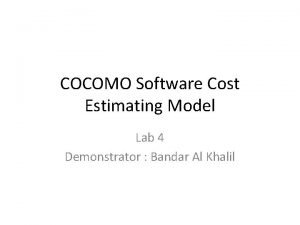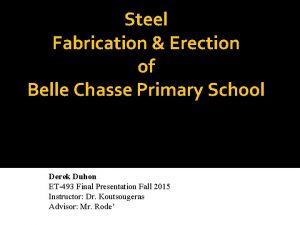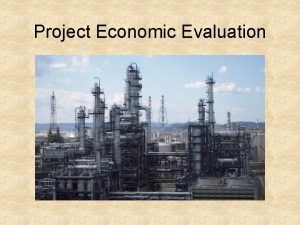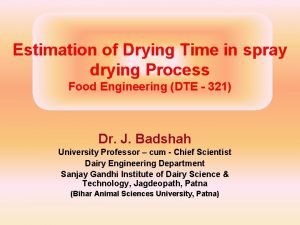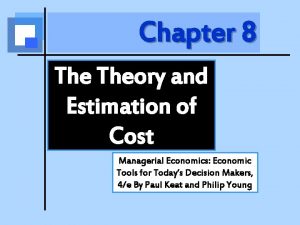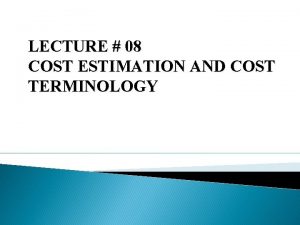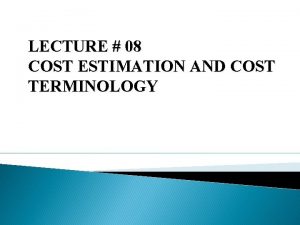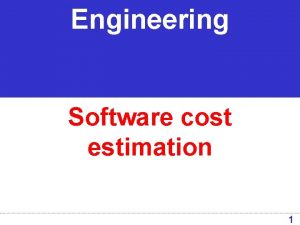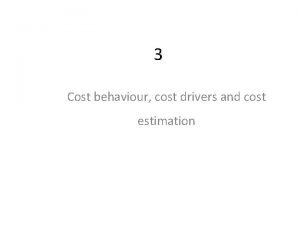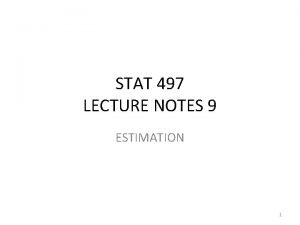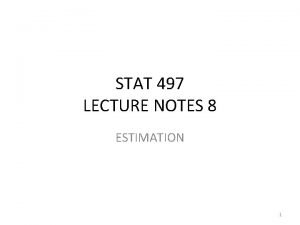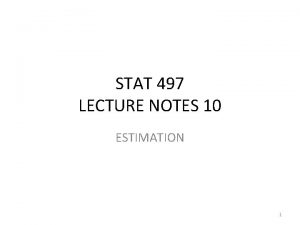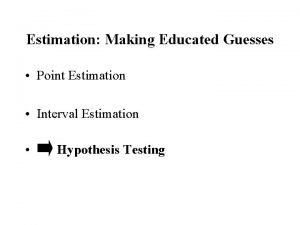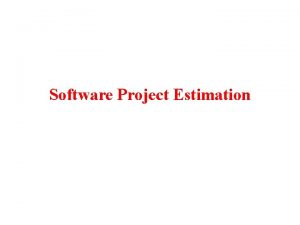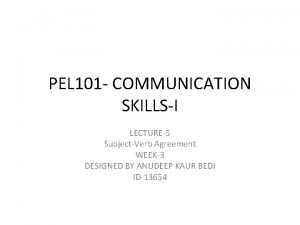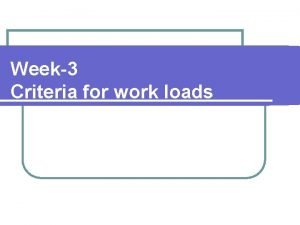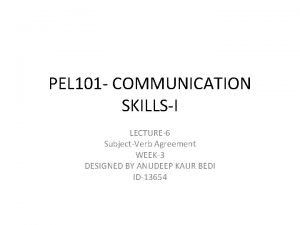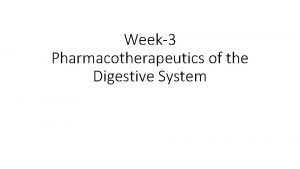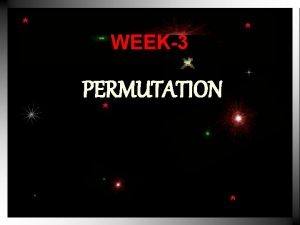COST ESTIMATION TECHNIQUES Lecture Notes Week3 THE PURPOSES



















- Slides: 19

COST ESTIMATION TECHNIQUES Lecture Notes, Week-3

THE PURPOSES OF ESTIMATION 1. To set selling price – as in quotation, tender bidding, and contract evaluation. 2. Profit analysis – for products or services. 3. Capital budgeting – cash outlay requirement. 4. Benchmark – for productivity improvement.

FUNDAMENTAL APPROACHES 1. Top down approach – based on historical data of similar projects. o o Use historical data on revenue, cost, and other estimates. Consider factors of inflation, changes in activity level, weight condition, present energy consumption, and other operating factors. 2. Bottom up approach – estimate based on present situation. o o Break down project into smaller manageable units. Use present situation to estimate revenue and costs.

Example 3 -1. Estimating the Cost of getting a University Degree – Top-down and Bottom-up Approaches Consider that the published cost of attending a university for bachelor degree is RM 15, 750 for the current year. This figure is anticipated to increase at the rate of 6% per year which includes full-time tuition and fees, university hostel, campus transportation and a monthly meal plan. The other costs that are not included into the published cost comprise of cost of books and printed materials, supplies, and other personal expenses. For our initial estimate, these “other costs” are assumed to remain constant throughout study period at RM 5, 000 per year. We now compute the estimated total costs of getting a bachelor degree at the university based on Top Tuition, Fees, Room, Transport Other Exp Estimated Cost down approach. (a) (b) (c)=(a)x(b) (d) (e) = (c)+(d) Year Rate Inflation Amount Total 1 15, 750 1. 06 16, 695 5, 000 21, 695 2 16, 695 1. 06 17, 697 5, 000 22, 697 3 17, 697 1. 06 18, 759 5, 000 23, 759 4 18, 759 1. 06 19, 884 5, 000 24, 884 Grand Total 93, 034

Bottom-up approach for the example 3 -1, we break down all the anticipated costs of getting a bachelor degree at the university as in the Figure below, Sum over four years of Total Cost for B. Sc degree Year-1 Year-2 Year-3 Year-4 Tuition, Fees, etc Tuition Desasiswa Fee Health & Welfare Fund Transport Insurance Books, Supplies Books Photostat Supplies Computer Living expenses Foods Clothing Recreation

INTEGRATED APPROACH Three basic components 1. Work breakdown structure (WBS) – define in details the work elements of project and relationships. 2. Classification of cost and revenue structure – delineation of revenue and cost in WBS. 3. Models for estimating techniques – select mathematical models the future revenue and cost.

INTEGRATED APPROACH …. . CONTINUE

THE WORK BREAKDOWN STRUCTURE (WBS) v. Basic tool to define project elements. v. Relationships between elements. v. Collecting and organising information. v. Developing relevant cost and revenue data. v. Integrating project management activities.

THREE-LEVEL WBS FOR COMMERCIAL BUILDING PROJECT

THE COST AND REVENUE STRUCTURE COST § Capital investment or outlay (fixed and working) § Labour costs § Material costs § Maintenance cost § Insurance § Overhead costs § Disposal costs REVENUE § Revenues from sales, etc § Market (or salvage) values

ESTIMATING TECHNIQUES (MODELS) Three basic types a) Rough (order-of-magnitude) estimates - level 1 or 2 in WBS (30% to +50%). b) Semi-detailed (budget) estimates - level 2 and 3 WBS (-15% to +15%). c) Detailed (definitive) estimates – implementation plan of WBS (-5% to +5%). The level of detail and accuracy of estimates depend on • Time and effort as justified by the importance of the study, • Difficulty in item estimates, • Methods or techniques used, • Qualifications of the estimator(s), and • Sensitivity of the study results to particular factors estimates.

SOURCES FOR ESTIMATING DATA Internal Sources External Sources 1. Accounting records – good 1. Published reports – on specified source for historical data but with area of interest, including some limitation when it is used for internet websites. estimation. 2. Other internal records– for instance operating results, engineering, sales, production/manufacturing, quality control, purchasing, and human resource. 3. R & D 2. Personal contact with the industry players – vendors, bankers, clients, government agencies, chamber of commerce, etc.

HOW ESTIMATES ARE ACCOMPLISHED 1. Conference – among the staff and stakeholders. Various method available, such as Delphi method, which involves cycles of questions and answers among the participants. 2. Comparison or estimating by analogy – based on additional available information, a new estimate for the alternatives is conducted and compared with the previous ones. 3. Quantitative technique – using previous data or simulated data in computer software (SPSS, SAS, etc)

MODELS OF ESTIMATION

Example 3 -1. Cost indexing The index for cost of purchasing and installing utility boiler is started in 1988 as a base year (index = 100). In the year 2000, a company ABC has installed a 1, 500 kg/hour boiler for RM 250, 000 when the index value was 350. The company ABC has to install another boiler of the same size in 2015. What is the approximate cost of purchasing the additional boiler if index value in 2015 is 450?

INDEXING ……CONTINUE

Example 3 -2. Weighted Index for Petrol Cost Based on the following data, develop a weighted index for the price of petrol per litre in 2010, when 1992 is the reference year having an index value of 99. 2. The weight placed on regular unleaded petrol is three times that of either premium ort unleaded plus, because roughly three times as much regular unleaded is sold compared with premium or unleaded plus. Price index in Year 1992 2006 2010 Premium 114 240 315 Unleaded plus 103 230 305 Regular unleaded 93 221 285


MODEL OF ESTIMATION ……CONTINUE 2. Unit Technique The unit technique estimates per unit factor of item, such as a) b) c) d) e) f) g) Capital cost of plant per kilowatt of capacity, Revenue per mile, Capital cost per installed telephone, Revenue per customer served, Temperature loss per 1, 000 feet of steam pipe, Operating cost per mile, Construction cost per square foot, etc.
 01:640:244 lecture notes - lecture 15: plat, idah, farad
01:640:244 lecture notes - lecture 15: plat, idah, farad Software cost estimation notes
Software cost estimation notes Chapter 2 an introduction to cost terms and purposes
Chapter 2 an introduction to cost terms and purposes Inventoriable costs examples
Inventoriable costs examples Basic estimation techniques
Basic estimation techniques What is demand forecasting and estimation
What is demand forecasting and estimation Objectives of cost estimation
Objectives of cost estimation Cost estimation in managerial economics
Cost estimation in managerial economics Cost estimation table
Cost estimation table Objectives of cost estimation
Objectives of cost estimation Price structure meaning
Price structure meaning Heat exchanger price estimation
Heat exchanger price estimation What is cocomo model
What is cocomo model Satellite cost estimation
Satellite cost estimation Cocomo cost estimation model
Cocomo cost estimation model How to calculate steel fabrication cost
How to calculate steel fabrication cost Capital cost estimate
Capital cost estimate Spray dryer cost estimation
Spray dryer cost estimation Estimation of cost function in managerial economics
Estimation of cost function in managerial economics Project procurement management lecture notes
Project procurement management lecture notes


